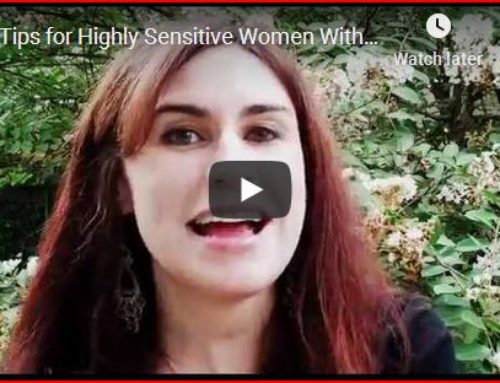 Do you have a fear that’s holding you back?
Do you have a fear that’s holding you back?
I want to share with you some tools I’ve used to overcome my own fears.
First, take a moment to think of one of your own, so you can immediately see how these tools can be applied. If you need some help, here are some juicy ones: fear of rejection, fear of getting hurt in a relationship, fear of public speaking, fear of flying, etc.
For me, a big one is my To Do list–basically not being able to do everything I expect of myself as well as I expect myself to do it. So for me using these steps means letting go of my expectations for what I can do in a given day, which can be a big challenge for me. What’s yours?
Step 1: Clearly Identify the Fear
It’s really important that you notice and admit to your fear, because it’s internal and easy to hide–even from yourself.
Most of us are masters at hiding our inner fears. No one can see our thoughts, and the actions we take to deal with our fears. There isn’t necessarily anyone to hold us accountable. So it’s really important to be honest with yourself and hold yourself accountable. That starts with admitting your fear and noticing how you handle it.
At this stage, give yourself a number from one to ten that describes how much fear you feel. Some people use a scale from 1 to 100, which gives more variability. But I like 1 to 10, because I think it’s less overwhelming. Use a scale that you feel comfortable with. This number is your baseline.
Step 2: Notice How You Respond
Now that you’ve identified your fear, notice how you respond to it.
There are 4 basic ways people tend to respond to fear, and none of these ways work in the long term. They all provide short term relief, but they create an addictive cycle. When you start to feel fear and anxiety, it’s a very uncomfortable feeling, so your first impulse is to decrease that feeling. These strategies make you feel better for a little bit, but then that uncomfortable feeling comes back…
Here are some ways you might respond:
1) Avoidance
2) Reassuring yourself it can’t possibly happen or asking others for reassurance
3) Forcing yourself to relax–maybe by meditating, listening to soft music or taking a hot bath (this works if your anxiety is low, but if it’s high you will most likely just find yourself frustrated that you can’t relax!)
4) Self-medicating with drugs and alcohol
Step3: Expose Yourself to Your Fear
The best way to dampen your fear down is to become bored with it. And you will become bored with it if you allow yourself to really feel all the anxiety and discomfort of your fear. Instead of avoiding your fear, you want to rush towards it, embrace it, and invite it in for tea.
Here are some ways you can expose yourself to your fear:
1) Do it anyway. Take an action towards whatever your afraid of. Your action could be public speaking, introducing yourself to someone you don’t know, reading an article on a topic that freaks you out, taking a flight if you’re afraid of flying…
2) Imagine doing it. If your fear is something you can’t realistically do right now (like take a flight) or you don’t feel ready to confront your fear, you can always start with a visualization.
3) Create your Horror Story. Write down your worst case scenario coming true. This is scary, but it can also be a funny way to start laughing at your fear. If you’re afraid of public speaking you can write a story about how you spilled something on your dress as you walked out on stage, forgot what you planned to say, and watched as thousands of people begin booing and leaving. Read this story to yourself over and over again for days until you become bored with it. It *will*eventually become boring and you will no longer feel an anxious reaction (or at least a weaker one) when you read it or think about it. You can also record your horror story as an audio recording and listen to yourself read it over and over again.
As you expose yourself to your fear, give yourself a number on a scale from 1 to 10. Your number will probably be higher as you begin exposing yourself to your fear, and you will probably feel worse for awhile–that’s normal. It does get worse before it gets better. This process of becoming bored with your fear can take a few days to a few months. Stick with it. You will get bored.
Step 4: Let it go
As you fully feel the emotion of fear and anxiety, it can be tempting to fall into a mental loop of worrying. Don’t go there. Feel the physical emotions fully, but do what you have to do to face your fear and move on. This is not avoidance, but keeping yourself from getting stuck. Continue to rate yourself on a scale from 1 to 10 and over time you will see this number go down.
You can get started facing a fear right now by leaving a comment and sharing a fear you can use these steps to work through *OR* share one of your tips for dealing with fear.







Yes, as you told I am facing.
That is good to hear–it’s tough but it works! 🙂
I am reading it again to feel it.
Overcoming Fears has been a running theme on my other blog and in my life in the last four years and these are great and clearly laid out steps. Love it and love the look of your blog!
Louise Edington
Hi Louise,
I’m so glad this is clear and easy to understand, and thank you for the compliment! 🙂
~Christina
I do this work with my clients, too, but it’s great to do the exercise ourselves! Thank you for laying out the steps clearly! 🙂
Hi Gladys,
Yes I totally agree–I use these tools myself so I completely get everything that comes up when I’m working with my clients too. Glad the steps are helpful!
~Christina
Great tips. Fear is always an interesting thing and one of the biggest factors that holds us back from truly being and doing what we would like. I can tell a lot about how a person handles fear based on their Human Design chart and help them understand this at their core level. Great post.
Hi Diana Marie,
Thank you so much for sharing. Understanding ndividual ways we respond to fear are such an important part of moving past it–your Human Design Chart sounds like a great tool for excavating that!
~Christina
I really like how you broke down step #2. So true that most of us avoid our fear and then find ourselves adopting a new addictive behavior to hide the fear even more. Nice breakdown for more breakthroughs! Thank you.
Hey Suzanne,
Thank you so much for sharing specifically what resonates for you. Step #2 is indeed counter-intuitive!
~Christina
Hi Christina, I love your article. I think that you truly give a great solution in taking our fears by the horns and totally winning the fight! I love the idea of imagining yourself going through the fear and doing whatever it is that scares you. Great share, Thank you 😉
Nathalie
Thank you Nathalie! I love the way you describe it 🙂
~Christina
Hi Christine,
beautiful article, I especially like the tip on exposing ourselves to fear.
In my healing practice I use a posture that helps trigger the event and the fear and have the client live the fear to the fullest.
By doing so and being there eventually the light steps in and the healing takes over gently and in a profound way.
Thanks for sharing and hope to connect with you again!
Hey Patricia,
Thank you for sharing that additional tool of combining a posture with the fear. That sounds really helpful. It’s great to hear from you here! 🙂
~Christina
This is such an important topic and you’ve provided some awesome tools to work with! Like most people I’ve dealt with a few fears (real and imagined) in my life – but the one that required me to be physically proactive was my fear of heights. Think about simple things like bridges,freeway overpasses, mountain roads … those things and more just threw me into a major anxiety attack. I overcame most of it by “doing it.” For example, I drove up this steep, narrow mountain twice a week – when I began I could only come within sight of the road before turning around. Eventually I made it all the way to the end of the road, and kept making that trip until I could do it without the pounding heart and sweaty hands. Small steps, but it lead to bigger steps and today, for the most part, I’ve put that fear behind me. Thanks for the inspiration!
Hey Marquita,
Thank you so much for sharing your story and your courage. That must have been extremely difficult, and I applaud you being brave enough to do it anyway. I’m not a big fan of bridges either, so I can relate to that! It’s interesting how some fears do require being physically proactive, while others can remain and not be a huge deal (like being afraid of spiders, for instance). It’s awesome to hear about you overcoming this fear!
~Christina
I have an irrational fear of vampires – not kidding! Since I was a kid – has to do with my best friend JoJo convincing me the neighbor across the street was a creature of the night. Only George Clooney I haven’t seen is Dusk to Dawn because it has vampires in it – yep, even George can’t get me over my fear here!
Hey Kimba,
Thank you for sharing! It’s so strange the little fears we pick up, isn’t it? I’m not such a huge fan of clowns, but starting to get more comfortable with them. Sounds like you could really have fun with the Horror Story Tool for this one–maybe even including George Clooney in it!
~Christina
Really relevant to read this post today Christina I really identify with your To-Do List – I’ve been having a ‘Oh cripes I can’t get everything done, things keep going wrong, I’m letting everyone down,I can’t keep up, my life is too full, I want to jump off day!!’- I turn into a grumpy person and take out this overwhelm on those around me – whilst beating myself up for not getting everything done just how I want it! I just want to run away and catch up!
I love your points you’ve written – today, for myself I broke things down and worked on routine things one by one as fast as I could to block out other stuff – and took each scenario, turned it around and thought – is it that bad? I filter the anxiety out and try to let the universe calm take over.Most issues resolved thenselves 🙂
I have so much exciting stuff going on in my head I need to draw a giant map of goals and actions – it just gets confused with all the day to day concerns which have to be done
I will remember your Creating Your Horror story, and then letting go next time,
thanks 🙂
Jacs
Hey Jacs,
Thank you so much for sharing and I’m glad this resonates. I am totally with you today on feeling the fear of the To Do list! The crazy thing is–like you said–is that it all resolves itself and its importance is totally an illusion. A few times today, I just had to stop and do nothing and let all that frantic energy go. It takes practice!
~Christina
With all due respect , meditation is very much an effective way to deal with fear – Especially the metta bhavana ( development of loving kindness towards oneself and others).
Contrary to what many people think , buddhist meditation is the complete opposite of pushing feelings away and avoiding them as is drug addiction .It’s about sitting with one’s emotions , feeling them , acknowledging them , and embracing them.
Understanding that every feeling we have is universal is an important aspect of moving through and past the negative ones that hold us back.
Since I started meditating a few months ago I have made progress in every area of my life . It’s the most beautiful thing I’ve ever done for myself.
I would encourage everyone here to include in their daily life.
🙂
Hi Clarice,
Thank you for adding that tip! Yes I totally agree, and there are some posts here on my site about using meditation as well. It can be used as an attempt to avoid anxiety (I know because I’ve been there and need to be mindful of that), but if you are allowing anxious feelings to come up while meditating, the same internal process is happening.
~Christina
[…] Starting an on line business does take learning some new skills and hard work. But if the above statement is your only objection, you may want to explore this belief rooted in fear. […]
[…] 1) Fear […]